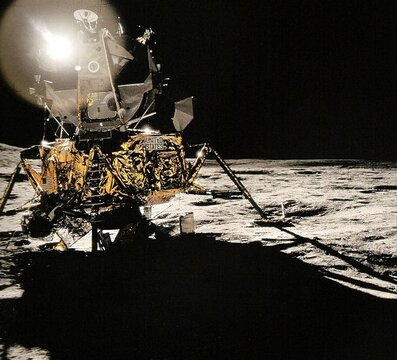David Biedny said:
That lunar surface, the lighting, scale, everything in that picture is exactly what you'd expect to see in a real photo of a LM above our moon.
How do you know that? Have you been there?
I suggest your mind has been programmed to accept that the Moon looks the way it does in the NASA images by repetitious exposure to those images. If the Moon would have been presented to you differently, with different features, your mind would identify those features with the real thing. How can I be sure? Because you have no way of verifying the authenticity of the images. Since you have already decided that the images must be authentic, your mind ignores all evidence to the contrary, and skips over any inconsistencies or logical impossibilities. In psychology, this process is know as confirmation bias: "In psychology and cognitive science, confirmation bias is a tendency to search for or interpret new information in a way that confirms one's preconceptions and avoids information and interpretations which contradict prior beliefs."
Confirmation bias - Wikipedia, the free encyclopedia
Here is a clip from the documentary "What Happened on the Moon?", which I posted before. I received no response from you or Gene concerning the evidence for wire rigs:
<object width="425" height="355"><param name="movie" value="
"></param><param name="wmode" value="transparent"></param><embed src="
" type="application/x-shockwave-flash" wmode="transparent" width="425" height="355"></embed></object>
In this sequence, filmed during the 1969 Apollo 11 press conference, the astronauts are asked if they could see stars from the Moon, and they replied "No". How extraordinarily improbable is that? How could that be? Even from Earth, through our atmosphere, we sometimes can make out the planet Venus during daytime. Yet we are led to believe that in a zero atmosphere environment, the astronauts could never see any stars? We should remember that stars are light-emitting suns.
<embed style="width:400px; height:326px;" id="VideoPlayback" type="application/x-shockwave-flash" src="
http://video.google.com/googleplayer.swf?docId=1754803469580790620&hl=en" flashvars=""> </embed>
Here is a more complete clip containing the Q/A session:
<embed src='
http://us.i1.yimg.com/cosmos.bcst.yahoo.com/player/media/swf/FLVVideoSolo.swf' flashvars='id=4304958&emailUrl=http%3A%2F%2Fvideo.yahoo.com%2Futil%2Fmail%3Fei%3DUTF-8%26vid%3D1207797&imUrl=http%253A%252F%252Fvideo.yahoo.com%252Fvideo%252Fplay%253Fei%253DUTF-8%2526vid%253D1207797&imTitle=The%2BApollo%2B11%2BPress%2BConference%2BOf%2B1969&searchUrl=
http://video.yahoo.com/search/video...id=&creatorValue=aG5yeXNhbmNoZXo=&vid=1207797' type='application/x-shockwave-flash' width='425' height='350'></embed>
When you scroll to about 3.30, you can hear Buzz Aldrin make the following statement: "We first set foot on the Moon in the deep shadow area." Here is where he gives the game away and makes it obvious that his and his fellow astronaut's statements are not truthful. If the astronauts were standing in "deep shadow", they would have been exposed to an extraordinary display of stars, planets and the Milky Way. Even if they would have tried, they would not have been able to ignore the stars, but they would have been able to take photos and record video images as well. You cannot have it both ways: Deep, black shadow areas on the lunar surface, and "glare" that makes it impossible to see the stars. This also renders all images that feature fill-in light impossible: Deep shadow means deep shadow. You cannot have it both ways:

